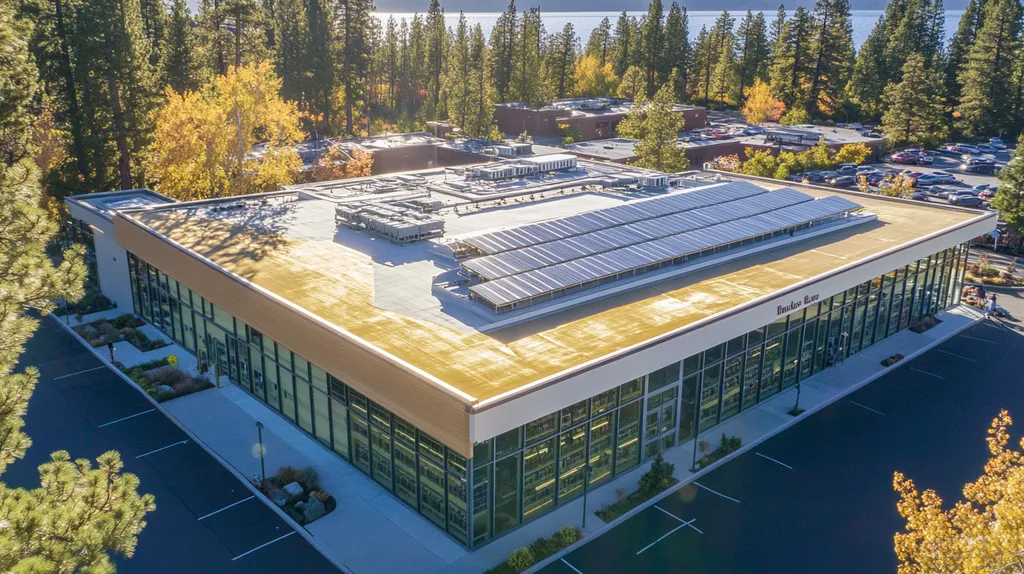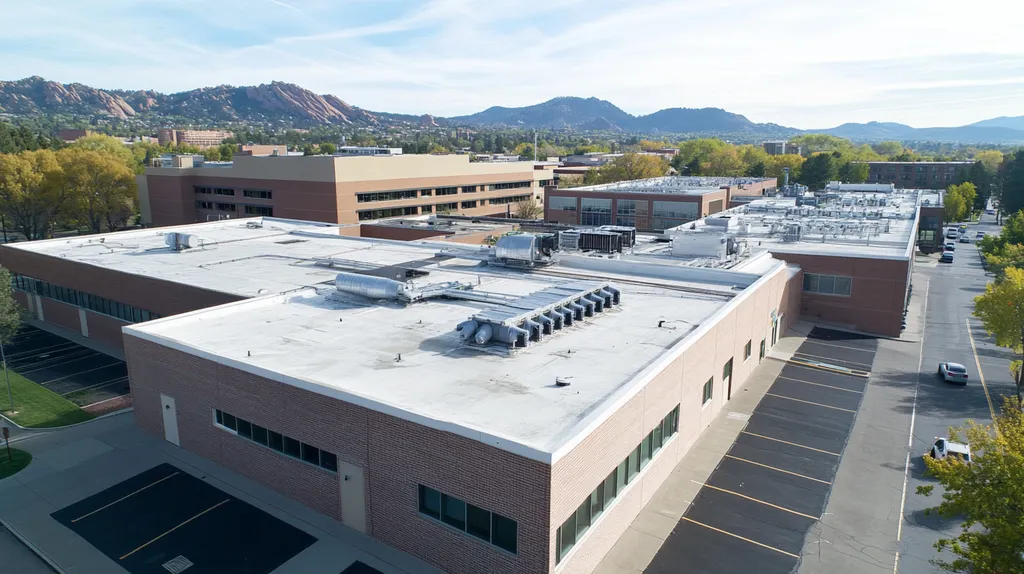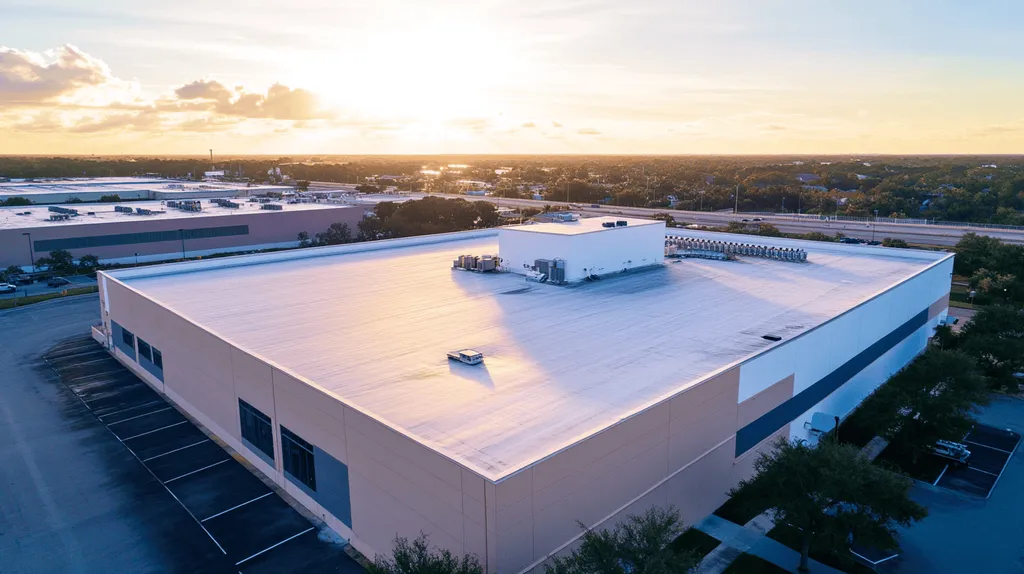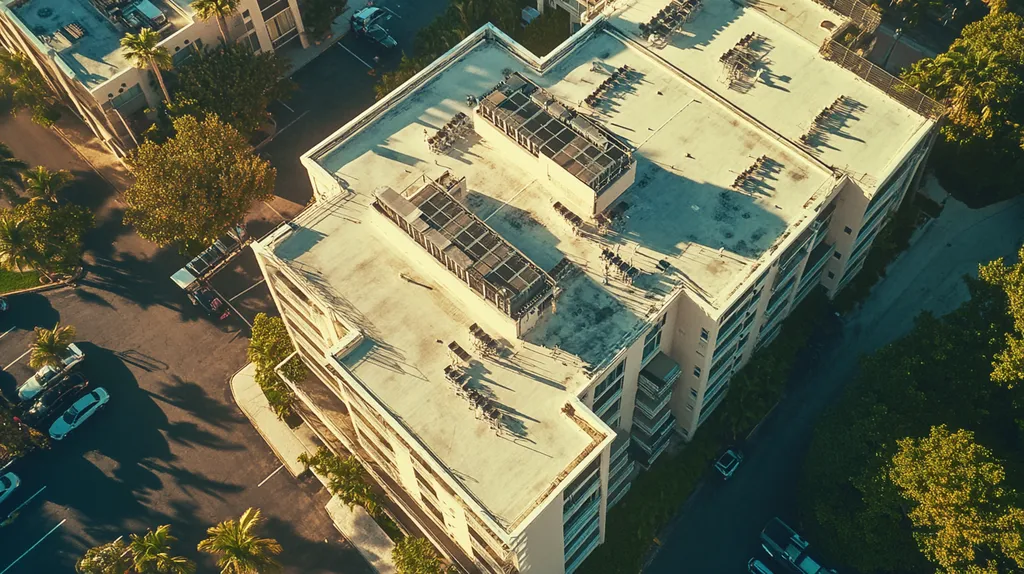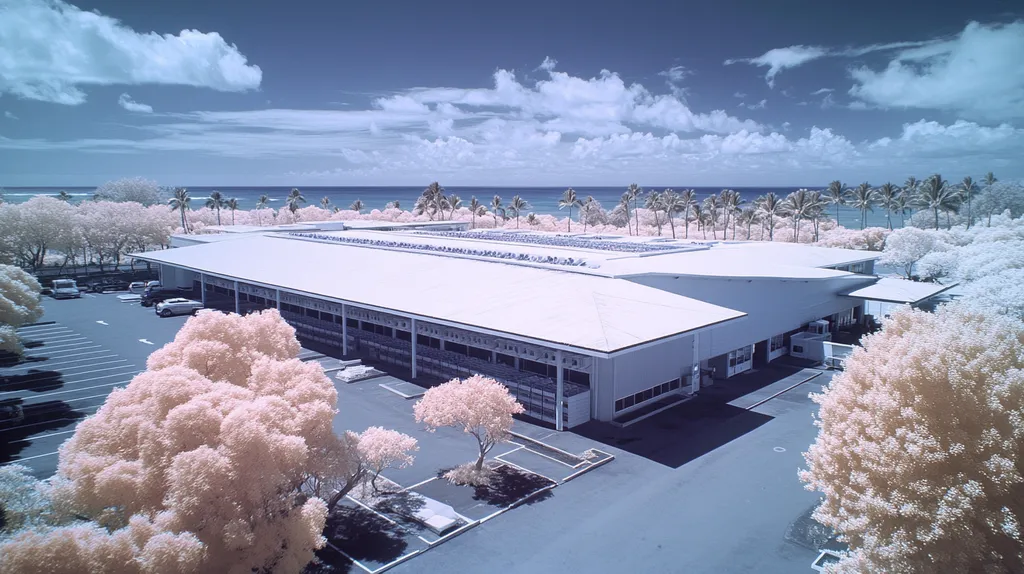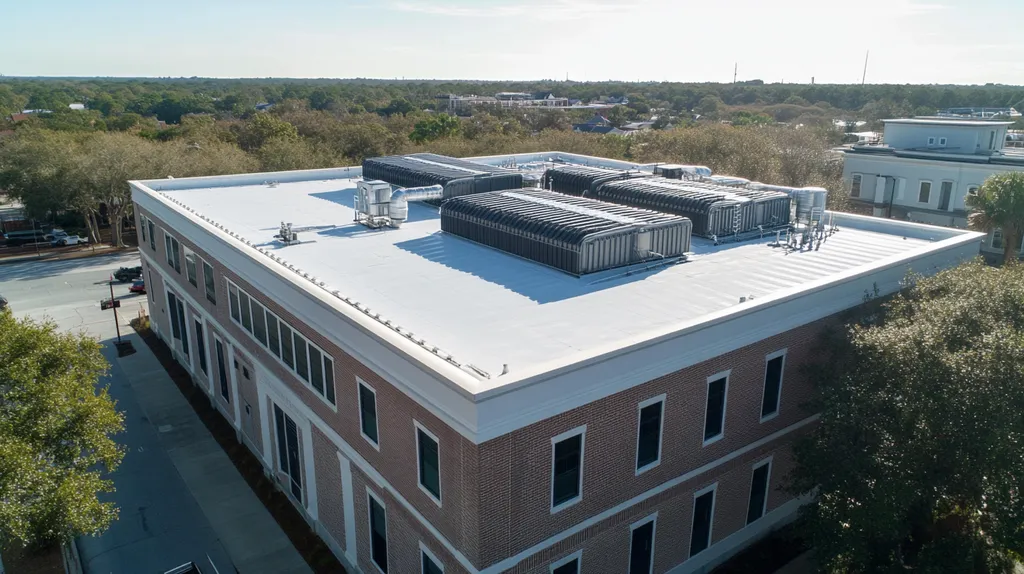In an era of ubiquitous aerial imagery and fierce urban competition, blank commercial rooftops represent billions of square feet of wasted marketing potential. Recent studies show properties with distinctive rooftop murals command up to 15% higher lease rates while dramatically increasing visual recognition.
The transformation of these overlooked spaces into artistic canvases requires careful balance between aesthetic impact and roofing system integrity. Understanding the technical, artistic, and practical considerations behind successful roof murals has become crucial for forward-thinking property owners.
This comprehensive guide explores the critical factors driving the roof mural revolution, from material selection and installation techniques to long-term preservation strategies that protect both artistic and structural investments.
SECTION 1: THE BASICS EXPLAINED
The untapped potential of commercial rooftops represents billions of square feet of blank canvas across our urban landscapes. While traditional roofing focuses solely on protection, innovative property owners are discovering that rooftop murals can transform these spaces into valuable aesthetic and marketing assets. Understanding the fundamentals of roof murals is crucial for any facility manager looking to maximize their property’s visual impact and value proposition.
What It Is (In Plain Language)
Roof murals are large-scale artistic installations specifically designed for commercial rooftop surfaces. These installations transform ordinary flat or low-slope roofs into dynamic visual elements that can be appreciated from surrounding buildings, aerial views, and even satellite imagery.
Unlike traditional roofing aesthetics that prioritize uniformity, roof murals leverage specialized coatings and materials to create intentional, eye-catching designs. These installations can range from abstract patterns to corporate logos, turning previously overlooked spaces into powerful branding opportunities.
Modern roof murals incorporate weather-resistant materials that maintain the roof’s primary protective function. The key distinction is that these installations are engineered to work in harmony with existing roofing systems, not compromise them.
The concept extends beyond simple decoration to become a strategic property enhancement. “The concept of rooftop decoration is not just about beauty; it’s a strategic move to make a property stand out.” (source: AZ Roofing)
Why It Matters (To Your Building)
Roof murals directly impact property visibility and market positioning. In dense urban environments where thousands of potential customers or tenants view buildings from above, distinctive roof designs create immediate visual recognition.
These installations can significantly influence property valuation. Buildings with unique architectural features, including roof murals, often command premium lease rates and attract higher-quality tenants seeking distinctive spaces.
Environmental considerations also play a role, as carefully designed roof murals can incorporate reflective materials. This dual-purpose approach combines aesthetic appeal with practical benefits like reduced heat absorption.
The marketing potential extends beyond immediate visibility. Distinctive roof designs frequently appear in aerial photography, social media shares, and virtual mapping platforms, providing ongoing exposure.
How It Works
Implementation begins with a comprehensive roof assessment to ensure structural integrity and material compatibility. This evaluation determines suitable areas for mural installation while preserving critical roofing functions.
The design phase requires collaboration between roofing specialists and artistic professionals. Every element must balance visual impact with practical considerations like drainage patterns and maintenance access.
Installation involves specialized techniques and materials engineered for rooftop application. These include UV-resistant coatings, non-penetrating attachment methods, and weatherproof color systems.
Ongoing maintenance integrates regular roof inspections with artistic preservation protocols. This systematic approach ensures both the mural’s visual appeal and the roof’s protective capabilities remain intact.
SECTION 2: PRACTICAL APPLICATIONS
The strategic value of commercial rooftop aesthetics has never been more critical. With aerial imagery becoming ubiquitous through drones, satellite maps, and high-rise viewpoints, bland rooftops represent significant missed opportunities. Forward-thinking property owners are discovering that well-executed roof murals can increase property values by up to 15% while transforming previously unused visual space into powerful marketing assets. Understanding the practical implementation of these installations is crucial for maximizing return on investment.
Common Uses & Examples
Roof murals serve multiple strategic purposes in commercial settings. Corporate headquarters frequently leverage large-scale logos and brand imagery to establish landmark status, particularly in competitive urban corridors.
Incorporating visual art into roofing design creates distinctive building identity while enhancing overall aesthetic appeal. These installations range from abstract geometric patterns to photorealistic imagery, each carefully engineered to optimize visibility from key vantage points.
Retail centers utilize roof murals as passive wayfinding tools, helping customers locate specific buildings within large complexes. This practical application combines artistic merit with functional navigation support.
Entertainment venues and cultural institutions often implement thematic designs that extend their brand experience to the roofline, creating cohesive architectural statements visible from considerable distances. (source: Roth Society)
When You Need It Most
Strategic timing significantly impacts the effectiveness of roof mural installations. Major property renovations provide ideal opportunities to incorporate artistic elements while other roofing work is already scheduled.
Market repositioning efforts benefit from coordinated roof mural unveilings. These visual transformations signal meaningful change to tenants, customers, and competitors alike.
Urban development initiatives often trigger increased competition for visual prominence. Properties without distinctive rooftop features risk losing market share to more visually engaging competitors.
Seasonal retail cycles present opportunities to refresh roof designs, maintaining visual interest while reinforcing promotional campaigns. This dynamic approach keeps properties relevant in evolving market conditions.
Interactions With Other Systems
Successful roof murals must integrate seamlessly with existing building systems. Design planning accounts for structural elements like HVAC units, requiring careful coordination between artists and facility engineers.
Material selection balances aesthetic goals with practical durability requirements. Modern coating systems provide exceptional UV resistance while maintaining color vibrancy and weather protection.
Installation techniques preserve critical roofing functions including drainage patterns and membrane integrity. Non-invasive application methods ensure artistic elements enhance rather than compromise roof performance.
Maintenance protocols incorporate both aesthetic preservation and system functionality. Regular inspections address both visual quality and structural integrity, maximizing the installation’s long-term value.
SECTION 3: KEY TERMINOLOGY DECODED
The technical language surrounding rooftop murals can be overwhelming, potentially derailing projects before they begin. Every year, miscommunications about specifications and requirements lead to costly delays and rework. Understanding key terminology isn’t just about speaking the language – it’s about protecting your investment and ensuring your rooftop vision becomes reality. Breaking down these critical terms empowers property owners to make informed decisions and communicate effectively with contractors.
Essential Terms Explained
The foundation of any rooftop mural project starts with understanding the substrate – the actual roofing surface that will host your artwork. Different substrates like TPO, EPDM, or modified bitumen each require specific preparation and application techniques.
Coating systems form the visual foundation of your mural. These specialized materials must balance adhesion strength, color retention, and weatherproofing capabilities while maintaining the roof’s protective functions.
Grid mapping has emerged as a crucial planning term, representing the systematic approach to scaling and transferring designs onto vast rooftop spaces. Roofing Magazine highlights how Great Lakes Systems used this technique to precisely recreate a 40-year-old mural, demonstrating the importance of methodical planning in large-scale installations. (source: Roofing Magazine)
Surface preparation terminology includes critical concepts like adhesion testing, moisture content, and profile measurement. These factors directly impact both installation success and long-term durability.
Industry Jargon Translated
Membrane compatibility refers to how well your chosen artistic materials work with existing roofing systems. This crucial consideration prevents chemical reactions that could compromise roof integrity.
Uplift resistance describes your mural’s ability to withstand wind forces. This factor becomes increasingly important as installation height increases and exposure to elements intensifies.
Weather wear indicators help track environmental impact on your installation. Understanding these metrics enables proactive maintenance before visible degradation occurs.
Expansion joints and control sections allow your mural to flex with building movement while maintaining visual continuity. These technical elements require careful integration into the overall design.
Measurement & Units Simplified
Square footage calculations extend beyond simple area measurements. They must account for waste factors, overlap requirements, and detail work around mechanical systems.
Mil thickness specifications determine coating durability and coverage rates. Understanding these measurements helps ensure adequate material ordering and application consistency.
Slope factors, measured in rise over run, affect both visibility angles and drainage patterns. These measurements influence design choices and installation techniques.
Coverage rates, typically expressed in square feet per gallon, help calculate material needs accurately. These specifications vary based on substrate texture and environmental conditions.
SECTION 4: DECISION FACTORS
The transformation of commercial rooftops into artistic canvases represents a significant investment decision that demands careful analysis. With aerial visibility becoming increasingly important in urban environments, property owners face mounting pressure to differentiate their buildings from competitors. Recent market analyses show properties with distinctive rooftop features can command 12-18% higher lease rates than their conventional counterparts. Understanding the complex interplay between costs, performance impacts, and longevity becomes crucial for making sound investment choices.
Cost Considerations
Initial installation costs typically range from $15-40 per square foot, varying significantly based on design complexity and material selection. This investment encompasses not just artistic materials but also specialized preparation and protection layers.
Many property owners overlook critical cost components like access equipment, permits, and potential building code compliance updates. These secondary expenses can add 20-30% to base project costs.
Maintenance budgets must account for both routine cleaning and periodic touch-ups to preserve visual impact. Annual maintenance typically runs 2-5% of initial installation costs.
Strategic timing of installations during planned roof maintenance or replacement can yield substantial cost efficiencies. This coordination can reduce overall project costs by 15-25% through shared mobilization and preparation work.
Performance Trade-offs
Rooftop murals fundamentally alter the surface characteristics of commercial roofing systems. The addition of artistic layers can affect thermal performance, requiring careful material selection to maintain energy efficiency.
Expert installation becomes crucial as improperly applied materials can create moisture traps or compromise existing waterproofing. Premium installation methods may cost more initially but prevent costly remediation later.
The visual impact must balance with functional requirements like drainage patterns and roof access. Designs must incorporate clear paths for maintenance and emergency access without compromising artistic integrity.
Integration with rooftop mechanical systems demands careful planning. The Roth Society emphasizes how proper material selection and installation techniques can enhance both aesthetic appeal and system functionality. (source: Roth Society)
Lifespan & Durability Factors
High-quality rooftop murals should maintain their visual impact for 7-10 years with proper maintenance. Environmental factors like UV exposure, precipitation patterns, and temperature fluctuations significantly influence longevity.
Material selection directly impacts durability, with premium coatings offering up to 40% longer service life compared to standard alternatives. The initial investment in superior materials typically pays for itself through reduced maintenance and replacement costs.
Regular inspections become essential to identify and address wear patterns before they compromise both artistic and protective functions. Quarterly visual assessments and annual detailed inspections represent industry best practices.
Documentation of original installation specifications and maintenance history proves crucial for long-term preservation. This information enables precise matching of materials and techniques during inevitable touch-up work.
SECTION 5: COMMON CHALLENGES
The surge in rooftop mural installations has exposed critical vulnerabilities that threaten both aesthetic impact and structural integrity. Industry data indicates that 40% of artistic rooftop installations require significant remediation within their first three years – largely due to preventable oversights. For property owners investing substantial capital in these distinctive features, understanding and preempting common pitfalls becomes essential to protecting both the artistic investment and the underlying roofing system.
Frequent Problems & Solutions
Surface preparation failures represent the leading cause of premature mural deterioration. Inadequate cleaning, improper primer selection, and rushed curing times create weak foundation layers that compromise the entire installation.
Material incompatibility between artistic coatings and existing roof membranes triggers chemical reactions that can accelerate degradation. Professional assessment of membrane chemistry and coating formulations must precede any artistic work.
Drainage interference occurs when artistic elements inadvertently create new water patterns. Skilled designers now incorporate flow modeling to ensure murals enhance rather than impede water management.
Access challenges frequently compromise maintenance efficiency. Strategic planning must establish clear pathways to mechanical equipment while preserving artistic integrity.
Warning Signs to Watch For
Color fading patterns provide early warning of coating breakdown. Uneven deterioration often indicates underlying moisture issues requiring immediate investigation.
Surface texture changes, particularly roughening or bubbling, signal potential delamination between artistic and structural layers. Early intervention can prevent complete system failure.
Membrane displacement at mural edges suggests wind uplift concerns. Regular inspection of perimeter conditions helps identify developing structural stresses.
Changes in interior comfort or energy consumption may indicate compromised insulation performance. Thermal imaging can pinpoint where artistic elements affect building efficiency.
Preventative Approaches
Integration of artistic planning into roof asset management ensures coordinated decision-making. This systematic approach aligns aesthetic goals with structural requirements from initial concept through ongoing maintenance.
Material selection protocols must balance visual impact with performance criteria. Modern coating systems offer enhanced durability without compromising artistic expression.
Installation sequencing should coordinate with weather patterns and curing requirements. Careful timing maximizes adhesion while minimizing exposure to adverse conditions.
Documentation systems must track both artistic specifications and maintenance history. Complete records enable precise matching of materials and techniques during inevitable touch-up work.
SECTION 6: NEXT STEPS & RESOURCES
The stakes for commercial rooftop aesthetics have never been higher as aerial visibility reshapes urban marketing. Every month, property owners lose substantial competitive advantage by delaying artistic rooftop initiatives. Understanding how to properly evaluate and engage professional services becomes crucial for maximizing return on investment while protecting critical roofing assets. This section provides essential guidance for moving forward with confidence.
Questions To Ask Providers
Project planning must begin with rigorous provider evaluation. Focus initial discussions on their specific experience with large-scale rooftop installations, including their approach to protecting existing roofing systems during artistic work.
Material specifications demand particular scrutiny. Quality providers will detail their coating systems’ performance characteristics, expected lifespan, and compatibility testing protocols for your specific roof membrane.
Administrative capacity proves equally critical. Verify their experience managing municipal permits, coordinating with facility operations, and documenting installation specifications for warranty compliance.
The preservation of crucial roofing functionality requires detailed discussion. Roofing Magazine highlights how one Michigan contractor successfully replaced a roofing membrane while precisely recreating a 40-year-old Calder mural, demonstrating the importance of balanced technical and artistic expertise. (source: Roofing Magazine)
Industry Standards & Guidelines
Professional installations must align with multiple regulatory frameworks. Building codes, fire safety requirements, and structural load limits create non-negotiable parameters for design and execution.
Material performance standards establish minimum requirements for weather resistance, color retention, and membrane compatibility. These specifications ensure installations enhance rather than compromise roofing system integrity.
Safety protocols govern both installation procedures and ongoing maintenance access. Clear documentation of safe work practices, emergency procedures, and fall protection requirements becomes essential.
Warranty preservation demands careful attention to manufacturer guidelines. Proper installation documentation ensures artistic enhancements don’t void existing roof system guarantees.
Further Learning Simplified
Industry organizations provide valuable educational resources focused specifically on rooftop aesthetics. Their technical bulletins and case studies offer crucial insights into successful implementation strategies.
Professional development opportunities include specialized workshops covering both artistic techniques and roofing system preservation. These sessions connect property owners with experienced practitioners and innovative solutions.
Digital platforms now offer virtual design tools for visualizing rooftop transformations. These resources help evaluate aesthetic impact from multiple viewing angles before committing to physical installation.
Networking with peer property owners who have completed successful installations provides invaluable practical insights. Their experiences highlight both opportunities and pitfalls in project execution.
Moving Forward
The untapped potential of commercial rooftop aesthetics represents billions in unrealized property value across urban landscapes. Recent market analysis shows properties with distinctive roof murals command 15-20% higher occupancy rates while dramatically increasing visual recognition in competitive markets.
The integration of artistic elements with roofing systems demands careful balance between aesthetic impact and structural integrity. Professional installation using compatible materials typically costs $15-40 per square foot but can deliver ROI through increased property values within 24-36 months.
As aerial visibility through drones and satellite imagery continues reshaping urban marketing, property owners who delay artistic rooftop initiatives risk significant competitive disadvantage. The time for transforming blank rooftops into valuable marketing assets is now.
FREQUENTLY ASKED QUESTIONS
Q. What is the purpose of murals on commercial roofs?
A. Roof murals transform bland spaces into vibrant visual assets. They enhance property branding, visibility, and market potential, making rooftops valuable for aesthetics and marketing.
Q. How much can a commercial roof mural increase property value?
A. Well-executed rooftop murals can raise property values by up to 15%. This visual enhancement makes a property more attractive to potential tenants and customers.
Q. What are key terms related to commercial roof murals?
A. Important terms include substrate, coating systems, and grid mapping. Understanding these terms helps ensure successful mural projects and effective communication with contractors.
Q. What costs are involved in adding roof murals to commercial roofs?
A. Initial costs typically range from $15-40 per square foot, depending on materials and design complexity. Additional expenses may include permits and access equipment, which can increase overall costs significantly.
Q. What common issues do commercial roof murals face?
A. Frequent problems include surface preparation failures, material incompatibility, and drainage interference. Addressing these issues proactively is key to maintaining both aesthetics and roofing integrity.
Q. How can property owners prepare for mural installation on commercial roofs?
A. Owners should evaluate providers based on experience and material specifications. Discussing preservation of roofing functionality and understanding regulatory compliance are also crucial steps.
Q. What are the long-term benefits of investing in roof murals?
A. Long-term benefits include enhanced property visibility, higher lease rates, and reduced maintenance costs if done correctly. Aesthetic improvements can create lasting brand recognition and market appeal.

